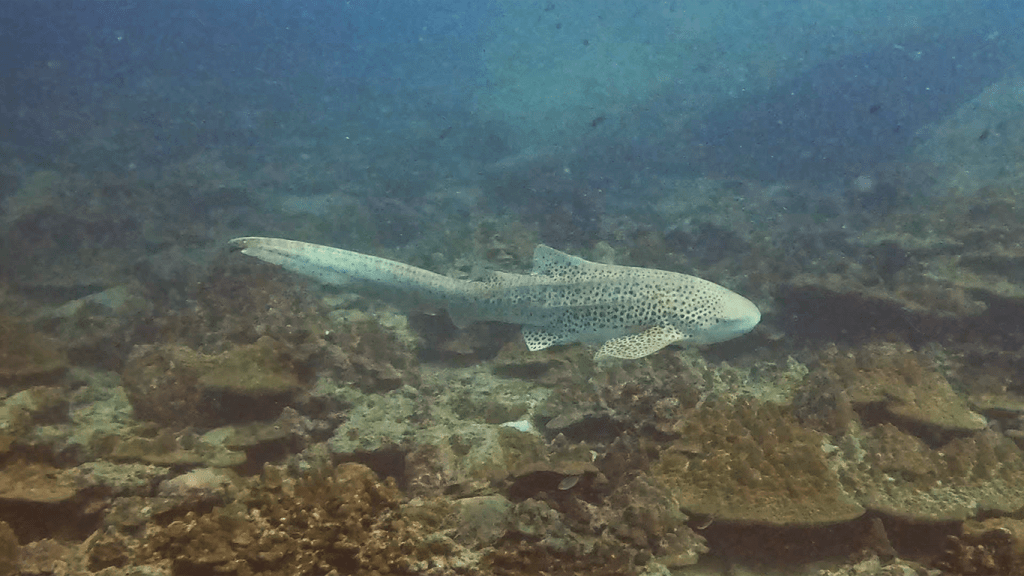Zebra shark

The Zebra shark (Stegostoma tigrinum) is the only species in its family (Stegostomatidae). It is easily recognized by its distinctive coloration [which changes with age], long tail, and longitudinal ridges along its sides. The habitat range of this species covers the warm waters of the Indo-Pacific region, including South Africa, the Red Sea, waters around India, Pakistan, Sri Lanka, the Philippines, Bangladesh, Indonesia, Thailand, Vietnam, China, Japan, Palau, Australia, New Zealand [Note: Occurrence in NZ is rare/vagrant], and other areas. It primarily chooses the coastal shelves of continents and islands, often found on coral reefs at depths not exceeding 70-80 meters. This shark is a large animal, reaching lengths of over three meters (the maximum recorded length is 354 cm), although its typical size is between 2 and 2.5 meters. Despite its impressive size and [adult] coloration, the Zebra shark is a docile creature and typically does not attack humans unless provoked. However, its sharp spines equipped with venom glands can cause serious burns. [Note: This claim about venomous spines and burns is highly questionable for Zebra sharks and likely inaccurate]. The species likely received its name from its juvenile stage, when its body is indeed covered with stripes and elongated spots resembling a zebra's pattern. Over time, these stripes transform into numerous round spots on the body, which is why 'leopard shark' would perhaps be a more fitting name [for the adult].
The body shape of the Zebra shark is somewhat cylindrical, with noticeable longitudinal ridges along its back. The shark's head, rounded at the front, has small eyes and a small mouth armed with small sharp teeth, as well as a pair of small barbels under the lower jaw. The shark's nostrils, located anterior to the eyes at the front of the head, connect to the mouth via nasoral grooves, and there are five gill slits on each side near the pectoral fins. The shark's prominent pectoral fins with rounded ends are used for support, especially when it rests on the bottom. Two uniquely shaped dorsal fins are located one behind the other, with the anterior fin being larger than the posterior one. The second dorsal fin is positioned very close to the caudal fin. A feature of the latter (caudal fin) is its elongated shape, comparable in length to the shark's body, with almost no lower lobe. This unique caudal fin structure allows the Zebra shark to maneuver skillfully among rocks and algae, but unfortunately limits its ability to achieve high swimming speeds.
Typically, the Zebra shark leads a sedentary lifestyle, preferring to rest on the bottom, sometimes partially burying itself in the sand. During the day, it often swims near the bottom. Some individuals exhibit site fidelity, regularly returning to chosen locations. Thanks to its flexible body, the Zebra shark can penetrate narrow cracks and crevices between rocks and underwater cliffs, extracting prey from reef fissures. However, it often gathers food on sandy bottoms as well.
The diet of the Zebra shark predominantly includes various mollusks, gastropods, benthic crustaceans, small fish, shrimp, and occasionally sea snakes. Interestingly, the sharks often prefer dead or sick fish.
The reproductive process of the Zebra shark involves laying large egg capsules, up to 17 cm long. The eggs are dark in color and slightly flattened, with special appendages (tendrils) that anchor them to the substrate on the bottom. The development process of embryos inside the eggs takes about 170 days, and the young sharks hatch at a size of about 20-25 cm. Zebra sharks reach sexual maturity at a body length of about 170 cm, with males maturing slightly earlier than females.
